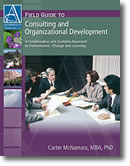How to Design Your Organization’s Structures
Assembled by Carter McNamara, MBA, PhD
Suggested Pre-Readings
Information about organizational design will have more context and meaning
if you have read the following articles and in this order:
1. What is an Organization?
2. What Makes Each Organization Unique
3. How They’re the Same: They’re Systems
4. Basic Overview of Life Cycles in Organizations
5. Basic Overview of Organizational Culture
6. Legal Forms and Traditional Structures of Organizations
7. Driving Forces and a New Organizational Paradigm
8. Emerging Nature and New Organizational Structures and Design
Sections in This Topic Include
- General Principles of Organizational Design
- Practical Advice About Organizing or Reorganizing
- Additional Guidelines for Organizational Design
- Developing Organization Charts
General Principles of Organizational Design
The section after this one shares practical advice about designing the structure of your organization. However, it might be interesting first to read about the general principles that the practical advice is following.
© Copyright Jim Smith
Some years ago Albert Cherns, an important figure in the Norwegian work redesign efforts highlighted some important Principles of Social and Technical Systems Design. The Principles of Organization Design have been known for 30 years in the academic and consulting community. Knowing the principles and implementing them are clearly two different things. First, I will detail the principles and following that I will highlight what has made the implementation so difficult.
1. Complementarities
How we go about restructuring needs to be compatible with what we are trying to achieve by the restructuring. The process of design must be complementary with the objectives. This means the design and implementation process is critical. If you want flexibility and participation within the work group as an output of the design, then how you go about designing the organization has to be flexible, interactive and participatory.
If the completed work system will depend upon high levels of meaningful flexibility in accomplishing the work, then it is through a process of meaningful flexibility that the system needs to be built. The “means” have to be complimentary with the “ends”. In other words, if you want a system where people assume responsibility, then people have to be responsibly involved in creating the work system or you won’t get it. We do not get participative highly effective organizations by fiat.
2. Minimal Critical Specification
New technologies require people to learn and change. These abilities have to be developed through the work itself. Therefore, specify as little as possible concerning how tasks combine into jobs and how people are to interact within jobs. The creation of a well-designed work team must involve dialogue and decisions being made by the people involved. Most teams struggle from over-structure, which is based in job descriptions and compensation schemes, which result in “that’s not my job”. The trick in building a team that works is to specify no more than is absolutely necessary about the task or how jobs relate to the task, or how people relate to individual jobs. To build a high performance team the rule is to FIX as little as possible. This means to identify and specify no more than what is absolutely critical. Generally the critical information is about output expected. The vision of results is very important and has to be co-constructed with the group but more than anything you want to build an organic ability to learn and change into the team.
3. Variance Control
Support and reward groups that deal with errors at the point of origin. Effective teams need the legitimacy to find out where things go wrong and deal with variance where it occurs. The goal is to minimize exporting problems to others. The assumption that is safe to make is that people know what good work looks like. Exporting problems and unsatisfied customer needs is the mark of a team that lacks options.
4. Clear Goals and Flexible Strategies
Define what is expected in terms of performance early and clearly and then support adaptations toward appropriate means by which the group can achieve ends. (Do not over-specify.) This is an adaptability principle, which recognizes that we are designing living systems rather than machines. With living systems, the same ends can be reached by different means. There are a lot of ways to solve problems and meet a customers needs.
What is critical here is the definition and understanding of the end goal. The “What” is to be highly specified. The “How” is open to local decision and initiative. This enables learning and an increased sense of “efficacy” on the part of team members. Efficacy is the sense that we are effective as a team that we can make a difference and do the job well. Efficacy is fragile and needs to be supported by continuous learning and improvement. High performance teams constantly “tinker” with the means by which they accomplish their results. They seldom settle on “one best way”
5. Boundary Location and Control
Supervisors and managers have to grow to become more comfortable performing a role as a group resource, a beacon of coming changes and a coordinator across task group boundaries.
Traditional organizations group by: time, technology or territory. The weakness of this is that boundaries interfere with the desirable sharing of knowledge and experience and so learning suffers. The consistent social-technical message is if there are supervisors, they manage the boundaries as a group resource, insuring the group has adequate resources, coordinating activities with other groups and foreseeing coming changes. More and more these resource positions are disappearing as groups become more self-regulating. Often the presence of supervisors is an indication of a lack of success in a groups design, or unwillingness at higher levels to trust based upon a poor job of building the structure. When it is done right supervisors are superfluous at best and harmful at worse.
6. Information Flow
Teams have to be deeply involved to determine what and where information is needed for self-direction. There needs to be a management commitment to provide information for task performance and learning. Information has to be provided where it is needed for self-direction, learning, and task improvement. Control has to be subordinated to achievement.
7. Support Congruence
Goals, reward and support systems that integrate required behaviors have to be consistent. The reward and support systems have to be consistent with goals. Incentives have to be realigned to support team-based work structures. Individual based compensation systems are being modified continually to support many different team structures. Skill-based schemes and gain sharing are foundations for high performance.
8. Design and Human Values
Task and organization design has to be oriented toward improving both the technical and the human components of the organization. The process of design must address the need for variation and meaning in work. It has to take into account the needs for continuous learning, involvement in decision-making, help and support between colleagues, and meaningful relationship between work and outside society, a desirable future. A re-design enterprise will be successful only if it unites a process of organization development, which includes work restructuring combined with a planning process that is both interactive and participatory.
9. Incompletion
Design is a continuous commitment, a reiterative process. A design is a solution, which inevitably has to be changed, therefore it is critical to build learning and change ability into the team. Management has to appreciate that organization design toward high performance is a continuous process. What has to be learned is the process of design because it is a never-ending necessity. Deep in our organizations, people have to learn how to periodically re-fashion their organizational arrangements. Everything falls out of balance and has to be reviewed with an eye toward deciding upon changes necessary. In the early stages learning how to redesign is often more important than the design itself. The design will change over time and learning how to do it is a team life skill.
The basic message is that if you want people to assume responsibility for the work process you have to involve them in the work redesign process itself. Responsibility is the essence of self-management. To accept responsibility people have to define and make decisions. The tendency is for management to hand the operational people an output of redesign thinking done by others, and expect them to work it. Expecting also, the supervisors to supervise the implementation of a design which management has completed. The trick of organizing for real teamwork is getting everyone involved in the total systems improvement.
Practical Advice About Organizing or Reorganizing an Organization and Its Employees
The following article shares advice about preparing for organizing and re-organizing, and then the practical advice to doing any of that.
Organizing or Reorganizing an Organization and Its Employees .
Also see
Organizing (how to arrange resources in organizations so people can work well together)
Additional Guidelines for Organizational Design
- What is Organization Design?
- Getting Organizational Design Right
- Got Structure? Need it?
- Strategic Organization Design -Training for Change
- Creating an Ambidextrous Organization
- Creating an Ambidextrous Organization – Part 2
- Creating an Ambidextrous Organization – Part 3
- Basic Terms in Staffing of Employees
Developing Organization Charts
Organization charts (or “org charts” as they affectionately are known) are graphical depictions of the official roles/positions in the organization and their relationship to each other, e.g., the top position and authority in the organization and then what other positions formally report to which other positions throughout the organization. Org charts are very common, especially in organizations with 5 or more people. The following guidelines will help you to understand org charts and how to develop them for your own organization.
- How to Build an Org Chart
- Organizational Chart (Wikipedia)
- The Power of Org Charts Done Right
- How Org Charts Lie
This Article is in a Series About Understanding Organizational Structures and Design
This article is the ninth in the series which includes:
1. What is an Organization?
2. What Makes Each Organization Unique
3. How They’re the Same: They’re Systems
4. Basic Overview of Life Cycles in Organizations
5. Basic Overview of Organizational Culture
6. Legal Forms and Traditional Structures of Organizations
7. Driving Forces and a New Organizational Paradigm
8. Emerging Nature and New Organizational Structures and Design
9. Basic Guidelines for Organizational Design
10. Wrap Up: Grasping the Big Picture in Organizations (video)
Learn More in the Library’s Blogs Related to Organizations
In addition to the articles on this current page, see the following blogs which have posts related to organizations. Scan down the blog’s page to see various posts. Also see the section “Recent Blog Posts” in the sidebar of the blog or click on “next” near the bottom of a post in the blog.
- Library’s Consulting and Organizational Development Blog
- Library’s Leadership Blog
- Library’s Nonprofit Capacity Building Blog
- Library’s Supervision Blog
For the Category of Organizational Development:
To round out your knowledge of this Library topic, you may want to review some related topics, available from the link below. Each of the related topics includes free, online resources.
Also, scan the Recommended Books listed below. They have been selected for their relevance and highly practical nature.


